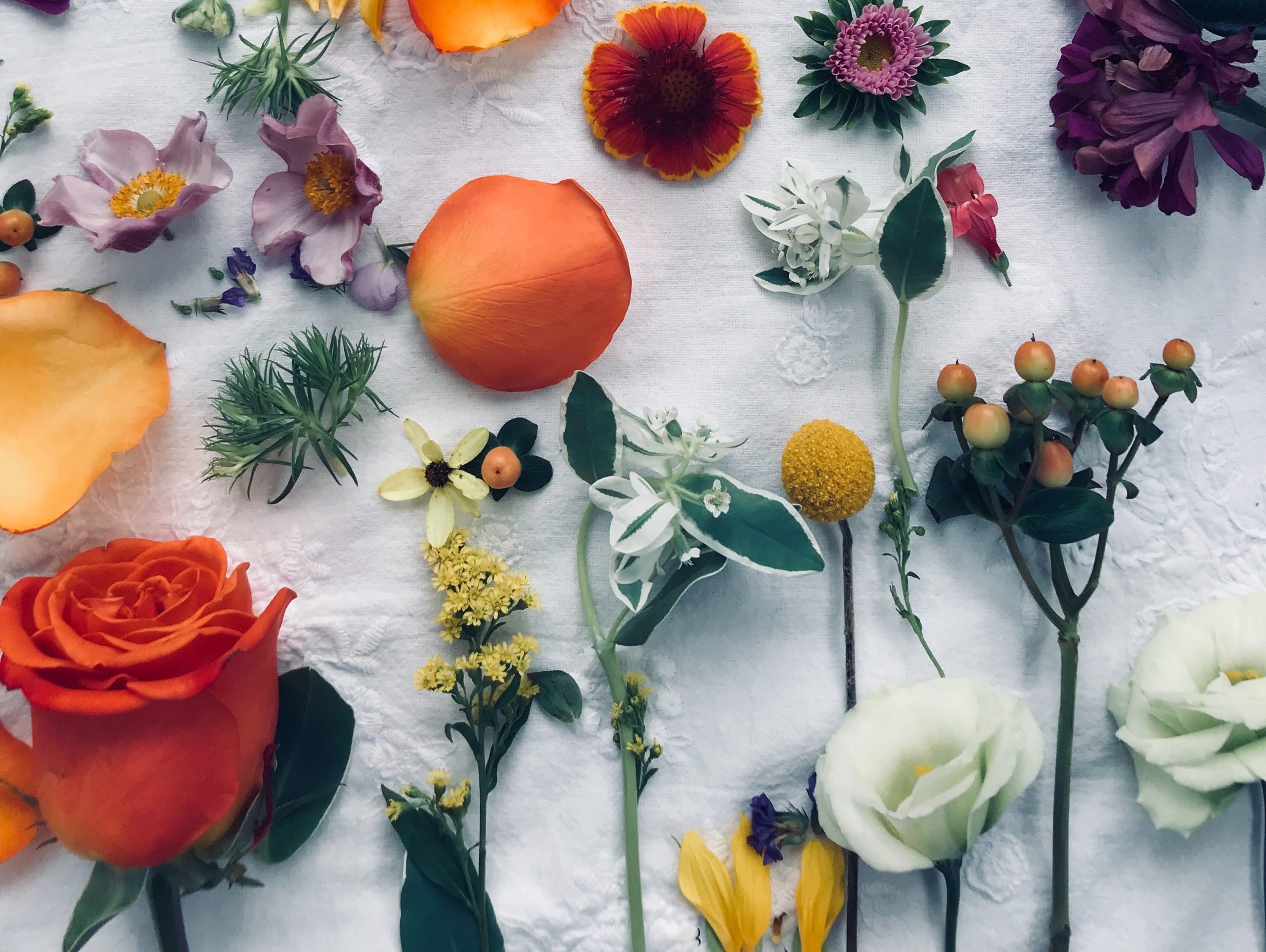Lit Mags
Incomplete Remains of a Millionaire Florist
"aila kageyama," flash fiction by Kiik Araki-Kawaguchi

Incomplete Remains of a Millionaire Florist
For Aaron Fai
aila kageyama
Aila Kageyama had an obsession for the boneless creatures and objects of this world. An orange-blossom custard for example. Or a rubber swim cap. Or a jellyfish. Even boneless concepts were attractive to her. Cultural appropriation was one. And the myth of model minorities. Whereas inverted totalitarianism was a road covered in bones. She preferred the mouthfeel of words without bones. Words like Lillian and illiterate and willfully were like sardines packed with little un-removable bones. But oboe and mandarin orange were delicate and juicy. A nugget usually was boneless. A succulent lump of white meat she could dip into a tub of honey. Except those Denver Nuggets who were a talented family of bones.
Those were the two classifications pervading her life. Either it was bones or no bones. Freddie Mercury was bones. The strawberry catsuit Britney Spears wore in “Oops!” was no bones. A t-bone steak was obviously t-boned. A portabella burger was a no-boner. It was less about a scientific definition. For Aila, sharks were bones, and dolphins were no bones, even though the opposite was scientifically true. But this was philosophy, not science.
A buttplug was a sort of flanged neoprene bone. But a human butt in and of itself was no bones. A human butt with a buttplug inside of it was definitely a bone-in situation. But a butt with only a tongue in it was boneless. She liked that one a lot. Also an oriental chicken salad was boneless. She ordered them whenever possible, as she liked to study the expression on the waiter’s face when she said oriental. She liked to say it a bit extra. I’ll have the oriental salad with the oriental dressing on the side. And I’ll add those oriental thigh meats on top. Are there mandarins in the oriental? Sometimes the salad showed up with wonton strips or upon a bed of uncooked ramen noodles in which case the experience was sort of semi-boned or bone-studded. A bed had bones, also known as a frame, but a mattress was boneless much like a colossal slab of calamari.
Aila had had sex on an inherited IKEA mattress thirteen times before leaving it with a FREE sign on the street corner. Twelve times at Azusa PU with Ranjit Roshan and the sex was like melting into butter pecan ice cream. The other time was a threesome she’d had back on senior prom night with the actors Sam Rockwell and Laura Linney. This had been in Aila’s sweaty post-prom dream, and she had climaxed twice, once into Sam Rockwell’s mouth, and once more riding atop Laura Linney’s multicolored strapon dildo. Why had she remembered that Laura Linney’s monster kongy-donk was luminous, almost kaleidoscopic, the way she imagined the skin of an archangel’s face? The detail had given the dream an amplified sense of realism. Even in her dream she remembered thinking, Laura’s dildo looks so expensive, so custom. Celebrities will spend on anything and have no regrets. Later while Aila was describing it all in her dream diary, she wrote, So strange to dream objects I have never seen, what does it mean to physically egggasm upon an object that was not physically present? And then she had skipped a line and written, Sex with ghosts possible????
Aila had been valedictorian of her high school. She had been voted Most Likely to Rule the World alongside Charles Rigaud Dalembert. She disliked the idea of ruling, but admittedly her favorite song was “Everybody Wants to Rule the World” by Tears for Fears. Roland Orzabal gave her all the lady-boners. There was a picture of Aila and Charles in the yearbook wearing royal mantles and holding plastic scepters. One girl plus one boy per Most Likely. Wasn’t this tradition a little odd? Who designed these ballots? There was something about it that felt like an arranged marriage.
Arranged or unarranged. Both could be beautiful. After Aila Kageyama dropped out of college she became a phenomenally successful florist. Flowers were the pinnacle of boneless beauty, and a florist did not have to remove bloodstains from her work clothes. “Aila’s Bloomsday” had three shops and thirteen delivery trucks. By her thirtieth birthday, her work had been featured in magazines and on the local news. She was the first of her friends to make ten million dollars.
But Aila’s success went unrecognized by her family. She was the youngest of six children. Five Kageyama children became heart surgeons. One Kageyama child became a florist. Aila was the butt of every joke at family gatherings. Could you cure a mangled heart with flowers? You could not.
As her siblings began to die, Aila designed each of them a unique and exquisite funerary arrangement. Black clamshell orchids were dominant for Reiko. She had died vacationing in Belize. Yellow gladioli for Harry. He was the funnest drunk Aila ever met. He had belted out the Morrissey at karaoke. White daisies for Mariko. She had died a virgin. The saddest no bones of all. Aila’s funerary arrangements always contained four hundred and forty-three blossoms. Aila and her siblings had spent their childhoods like sardines packed into a two-bedroom one-bathroom apartment at 443 Mourning Cloak Way. Her parents had slept on bunk beds in the living room. The children slept atop each other as though skewered. On warm summer nights, Aila had pitched a tent on the Kageyama patio of dying plants. In that Kageyama apartment, the plants and animals were eaten down to their bones. The bones were boiled for stock. The stock was eaten down to its residue. Not much made it to their garbage bins.
In her ninety-ninth year, Aila was the last of the Mourning Cloak Kageyamas to go. She had given careful instructions for how to tend to her remains. She did not want cremation. She wanted to be slipped naked into a thin biodegradable casket sack and buried beneath an apple orchard. She preferred Pacific Roses or Honeycrisps, but Fujis or Pink Ladies would be OK too.
Aila’s children promised to go along with the dead-nude-into-Fujis idea, but in the end they decided to cremate her anyway. Cremation simply seemed the faster and cleaner choice. And Aila’s senior living community was a bit of a one-stop shop. In the final years of Aila’s life, she was moved from one ward to the next, independent living to partial care, partial care to the Alzheimer’s bunkers. From all her apartment windows she could see the tall black concrete tower, the community’s cremation chamber. The air always smelled faintly like a holiday barbecue.
On the afternoon of Aila’s death, her children had not checked the box asking if they wanted their mother’s “complete” remains. They did not understand this meant with or without the bone fragments that survived incineration. They were given the boneless remains, and they placed them inside an ornate cinerary urn. They had felt a little bad about cremating against their mother’s wishes, and so they sprung for the most expensive cinerary urn they could find on Etsy. It was about a four-hundred-dollar purchase, including the discount code for free shipping. The cinerary urn was placed upon a glass shelf in a curio cabinet beside an oil painting of an apple orchard. Aila’s son had done the painting himself, and it was very poor.
Many years later, the curio cabinet and the painting and Aila were sold as a single item in an estate sale. The buyer was Reyansh Roshan, the great-grandson of Ranjit Roshan. Good old bones on this cabinet, he thought, patting it lovingly. Reyansh really hated the apple orchard painting though, and he placed it atop the trash bins with a FREE sign taped upon it. He presumed the cinerary urn was decorative pottery, and so he kept Aila there inside.








